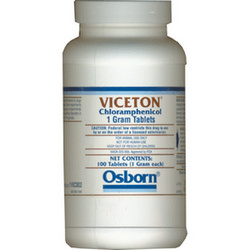Save on All Your Summer Essentials: From Calming Products to Flea & Tick Solutions and More!
Chloramphenicol (Viceton) Tablets
SKU : 29501-EA_-RX

Price: $0.99
Save 15% on your first Autoship order
+ Save on each recurring order!
+ Save on each recurring order!
Veterinarian Prescription (Rx) Required
Free Shipping on orders over $75Low Price Match Guarantee
- Broad-spectrum antibiotic
- Recommended for oral treatment of the following conditions in dogs: Bacterial pulmonary infections caused by susceptible microorganisms such as: Staphylococcus aureus, Streptococcus pyogenes and Brucella bronchiseptica
- Available Sizes
- 1 gm Single tablets or 100 ct Botle
- 250 mg Single tablets or 500ct
How to Order Prescriptions
Description
Chloramphenicol Tablets are recommended for oral treatment of the following conditions in dogs:- Bacterial pulmonary infections caused by susceptible microorganisms such as: Staphylococcus aureus, Streptococcus pyogenes and Brucella bronchiseptica.
- Infections of the urinary tract caused by susceptible microorganisms such as: Escherichia coli, Proteus vulgaris, Corynebacterium renale, Streptococcus spp. and hemolytic Staphylococcus.
- Enteritis caused by susceptible microorganisms such as: E. coli, Proteus spp., Salmonella spp., and Pseudomonas spp.
- Infections associated with canine distemper caused by susceptible microorganisms such as: B. bronchiseptica, E. coli, P. aeruginosa, Proteus spp., Shigella spp. and Neisseria catarrhalis.
Additional adjunctive therapy should be used when indicated. Most susceptible infectious disease organisms will respond to chloramphenicol therapy in three to five days when the recommended dosage regime is followed. If no response to chloramphenicol therapy is obtained in three to five days, discontinue its use and review the diagnosis. Also, a change of therapy should be considered.
Laboratory tests should be conducted including in vitro culturing and susceptibility tests on samples collected prior to treatment.







